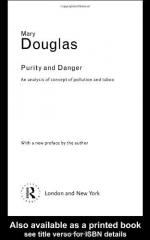
|
| Name: _________________________ | Period: ___________________ |
This test consists of 15 multiple choice questions and 5 short answer questions.
Multiple Choice Questions
1. How do the Lele distinguish between pollution and purity?
(a) Classifying animals.
(b) Using certain hands for certain actions.
(c) Washing hands before preparing food.
(d) Using fire in sacrifices.
2. When do Orthodox Brahmins marry off their daughters?
(a) After they begin menstruating.
(b) Before puberty.
(c) After puberty.
(d) Before birth.
3. To create order, what does Douglas believe one must acknowledge?
(a) Faith.
(b) Tidiness.
(c) Composure.
(d) Disorder.
4. In South India, who can marry?
(a) Eldest sons.
(b) Elderly men.
(c) Eldest daughters.
(d) Youngest sons.
5. What do the Lele men compete for?
(a) Homes.
(b) Wives.
(c) Sex with multiple women.
(d) Children.
6. Which of these is not a pollution that Douglas distinguishes?
(a) Refraining from purity.
(b) Crossing internal boundaries.
(c) Crossing external boundaries.
(d) The lines' margin.
7. What may the Nuer kill in defense for, according to Douglas?
(a) Their children.
(b) Their rights.
(c) Their food.
(d) Their homes.
8. What do external boundaries involve, according to Douglas?
(a) Perosnal inclinations.
(b) Purity.
(c) Communcal sacrifice.
(d) Social order.
9. What did Vann Gennep associate danger with?
(a) Dancing.
(b) Menstrual blood.
(c) Transition.
(d) Faith.
10. In Bemba culture, what can cause death?
(a) Boundaries.
(b) Fire.
(c) Lying to an elder.
(d) Sex.
11. What type of behavior does the pollution Douglas describes reflect?
(a) Righteous.
(b) Religious.
(c) Good.
(d) Wrong.
12. What types of nationalities are deemed to represent power and invite discrimination, according to Douglas?
(a) Those with complete purity.
(b) Those with knowledge and skills.
(c) Those with unexplained advantages.
(d) Those with faith.
13. As excrements pass the boundary of the body, what do they present to the cultures Douglas describes?
(a) Purity.
(b) Sacrifice.
(c) Pollution.
(d) Danger.
14. What do the Lele regard as the cause of early death and source of all evil?
(a) Sorcery.
(b) Rivalry.
(c) Sex.
(d) Sinful living.
15. Whose life is put at risk when a wife commits adultery in the Nuer society described?
(a) The wife's first son.
(b) The wife's husband.
(c) The wife's lover.
(d) The wife.
Short Answer Questions
1. What do the Nuer determine their moral code through?
2. What type of collaboration does Douglas believe must be maintained to assure social life is preserved?
3. What does the allegiance established through marriage determine in Purity and Danger?
4. The model of sexual energy that Douglas describes is a basis of what?
5. Rejecting or affirming dirt has little to do with which of the following described by Douglas?
|
This section contains 386 words (approx. 2 pages at 300 words per page) |

|




